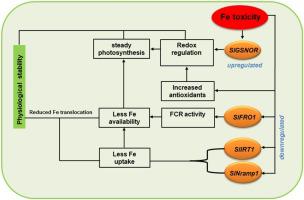Scientia Horticulturae ( IF 3.9 ) Pub Date : 2021-01-15 , DOI: 10.1016/j.scienta.2021.109897 Urmi Das , Md Rijoanul Islam , Mst Salma Akther , Sadia Akter Prity , Md Sarwar Parvez , Ahmad Humayan Kabir

|
This study illustrates the mechanisms underlying differential tolerance to iron (Fe) toxicity in tomato. Excess Fe exhibited a substantial reduction in morphological parameters in Marglobe (sensitive), while Ratan (tolerant) remained unaffected. Excess Fe increased root and shoot Fe concentrations in Marglobe, but Ratan showed no changes accompanied by the downregulation of SlIRT1 (Fe-regulated transporter 1), SlNRAMP1 (Natural resistance-associated macrophage protein 1), and SlFRO1 (ferric chelate reductase 1) in the roots. Furthermore, the leaf chlorophyll score remained unchanged, but root Fe-chelate reductase substantially decreased in Ratan; while, these features significantly increased in Marglobe following Fe toxicity. The SlIRT1, SlNRAMP1 and SlFRO1 genes are located in the plasma membrane and possess a shared gene network generally consisting of NRAMP1(Natural resistance-associated macrophage protein 1),NRAMP3(Natural resistance-associated macrophage protein 3),FRO1 (ferric chelate reductase 1), FER (BHLH transcriptional regulator) and CHLN (nicotianamine synthase) that are linked to Fe uptake in plants. Further, the quantum yield of PSII in leaf showed no changes, but the photosynthetic performance index, electron transport flux, and active antenna size notably decreased in Marglobe, while Ratan showed steady status. Moreover, Fe toxicity showed an elevation in antioxidant enzymes (SOD, CAT, APX, GR), glutathione, and cysteine in roots of Ratan, providing defense to oxidative damage, while early Fe-toxicity possibly caused oxidative damage before photosynthetic impairment in Marglobe. Additionally, nitric oxide concentration and the expression of SlGSNOR (S-nitrosoglutathione reductase) gene were significantly induced in Ratan while this was unchanged in Marglobe under Fe toxicity. This SlGSNOR gene showed a close relationship with the Arabidopsis homolog, as evident in the sequence alignment. Further, nitric oxide donor improved plant length and biomass even in Marglobe, indicating the possible association of nitric oxide signaling in Fe-toxicity tolerance in tomato. This is the first to show the mechanistic consequence of differential tolerance to Fe toxicity in tomato.
中文翻译:

质膜中铁捕获基因的下调以及抗氧化防御和一氧化氮信号传递赋予番茄对铁的毒性耐受性
这项研究阐明了番茄对铁(Fe)毒性的不同耐受性的潜在机理。过量的铁在Marglobe(敏感)中表现出形态学参数的显着降低,而Ratan(耐受)则不受影响。过量的铁增加了Marglobe的根和茎中铁的浓度,但Ratan并未显示任何变化,而与SlIRT1(铁调节的转运蛋白1),SlNRAMP1(与自然抗性相关的巨噬细胞蛋白1)和SlFRO1(铁螯合还原酶1)下调有关。根。此外,在Ratan中,叶绿素得分保持不变,但根Fe-螯合物还原酶显着降低。而这些特征在铁中毒后在Marglobe中显着增加。该SlIRT1,SlNRAMP1和SlFRO1基因位于质膜上,并拥有一个共享的基因网络,该网络通常由NRAMP1(与自然抗性相关的巨噬细胞蛋白1),NRAMP3(与自然抗性相关的巨噬细胞蛋白3),FRO1(铁螯合物还原酶1), FER(BHLH转录调节因子)和CHLN(烟碱胺合酶)与植物体内铁的吸收有关。此外,叶片中PSII的量子产率没有变化,但是在Marglobe中,光合性能指标,电子传输通量和有效天线尺寸显着降低,而Ratan则显示稳定状态。此外,铁的毒性显示出Ratan根中的抗氧化酶(SOD,CAT,APX,GR),谷胱甘肽和半胱氨酸升高,为氧化损伤提供了防御,而早期的铁毒性可能在Marglobe的光合损伤之前引起了氧化损伤。另外,一氧化氮浓度和SlGSNOR(S-亚硝基谷胱甘肽还原酶)基因的表达在Ratan中被显着诱导,而在Marglobe中在Fe毒性下没有改变。这个SlGSNOR如序列比对所示,该基因与拟南芥同源物显示出密切的关系。此外,一氧化氮供体甚至在Marglobe中也改善了植物长度和生物量,表明一氧化氮信号传导可能与番茄对铁的毒性耐受有关。这是第一个显示出对番茄中Fe毒性差异耐受性的机理性结果。









































 京公网安备 11010802027423号
京公网安备 11010802027423号